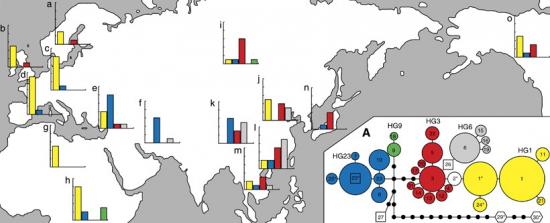2011 study: Dogs were first domesticated in the southern part of East Asia (South of Yangtze River)
Source - http://heritageofjapan.wordpress.com/
Below is an excerpt from the abstract of the latest genetic study “Origins of domestic dog in Southern East Asia is supported by analysis of Y-chromosome DNA“ suggesting that the possible place where the dog was domesticated was in the region south of the Yangtze River.
Figure 1 is particularly interesting as it suggests that the domestic dog in Japan is a mixture of two types, originating from the Middle East-through-Western Asian (Yunnan-Tibet) belt and also from the Southeast Asian regions, which would correspond closely to the dual structure theory of Japanese origins (and distribution of Jomon genes (haplogroups D and YAP+ (Y-DNA) and M7(mtDNA) vs. Yayoi or post-Yayoi-and-Kofun eras (haplogroups O2b/O3)

Map showing phylogenetic and geographical distribution of dog haplotypes (adapted from Table 1) Origins of domestic dog in Southern East Asia is supported by analysis of Y-chromosome DNA - Z-L Ding et al., Heredity
Global mitochondrial DNA (mtDNA) data indicates that the dog originates from domestication of wolf in Asia South of Yangtze River (ASY), with minor genetic contributions from dog–wolf hybridisation elsewhere.
Two haplogroups were universally shared and included three haplotypes carried by 46% of all dogs, but two other haplogroups were primarily restricted to East Asia. Highest genetic diversity and virtually complete phylogenetic coverage was found within ASY. The 151 dogs were estimated to originate from 13–24 wolf founders, but there was no indication of post-domestication dog–wolf hybridisations. Thus, Y-chromosome and mtDNA data give strikingly similar pictures of dog phylogeography, most importantly that roughly 50% of the gene pools are shared universally but only ASY has nearly the full range of genetic diversity, such that the gene pools in all other regions may derive from ASY. This corroborates that ASY was the principal, and possibly sole region of wolf domestication, that a large number of wolves were domesticated, and that subsequent dog–wolf hybridisation contributed modestly to the dog gene pool.
NB: The abstract also notes that “there is yet no consensus concerning in which geographical region the domestication of wolf occurred. Studies of mitochondrial DNA (mtDNA) from dogs worldwide have strongly indicated the southern part of East Asia (dubbed Asia South of Yangtze River, ASY) (Savolainen et al., 2002; Pang et al., 2009; Klütsch and Savolainen, 2011). Archaeological data has instead indicated an origin from Europe or Southwest (SW) Asia or from multiple regions (Clutton-Brock, 1995), and a recent study of autosomal single nucleotide polymorphism (SNP) data suggested SW Asia as the major source of genetic diversity for dogs (Vonholdt et al., 2010). However, both the archaeological- and the autosomal-SNP datasets suffer from geographical bias, in that they almost totally lack data from ASY (Klütsch and Savolainen, 2011).”